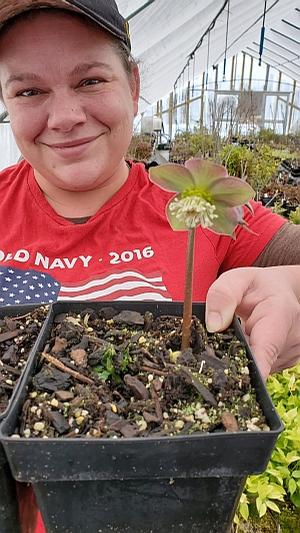Printed at http://www.quackingrassnursery.com/index.cfm/

Helleborus purpurascens WM.9922 - an aging flower with foliage just beginning to stir; Rachel beaming in this pic.
Helleborus purpurascens WM.9922
Hellebore
Plant Type:
SHADE PERENNIALSHelleborus purpurascens WM.9922 - This lovely Helleborus is more demure than the larger H. x hybridus cultivars. Purple early to mid-spring single hellebore flowers top dissected, toothed and matte-finished leaves in a palmate form. The flowers occur early in the Hellebore processional, usually shortly after H. niger and H. orientals subsp. abchasicus. Hellebores are incestuous as evidenced by the taxonomists changing the H. orientalis moniker to x hybridus. Why? Because the taxonomy was so confused because of all the interbreeding. But these are true H. purpurascens having been grown from a selection made in its wild haunts. Some morning sun to dappled shade in fertile, moisture retaining soil. Established potted Purple Hellebore from division.
Characteristics and Attributes for Helleborus purpurascens WM.9922
Season of Interest (Flowering)
- Spring
Season of Interest (Foliage)
- Spring / Summer / into Autumn
Nature Attraction
- Honey Bees & Native Bees
Light
- Morning Sun / Afternoon Shade
- Dappled Shade
Attributes
- Border
- Woodland
- Collector Plant
- Cottage Garden
Growth Rate in the Garden
- Slow
Soil
- Draining
- Fertile
- Moist
Origins
- Western Europe
Propagated By
- Division
Genus Overview: Helleborus
Hellebores are indispensible in the woodland garden. They are among the earliest, herbaceous plants with the largest, showiest flowers to brave late winter/early spring cold temperatures and shine, shine, shine! Flowers often age to chartreuse (certainly in H. x hybridus) extending the bloom effect. The foliage for most of the following perennials lasts for nearly 3 seasons – from spring until the following winter solstice in northeastern Connecticut. It is said that lime in the planting hole is helpful. We have never done so and they perform wonderfully for us. Open shade, dappled conditions, morning sun/afternoon shade is best. Plant them in any good woodland soil with organic matter. All of the following are offered as pot grown by good old-fashioned perennial division. In the north spring planting is strongly recommended.


